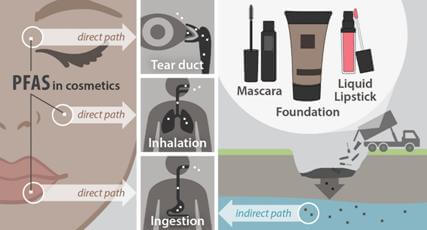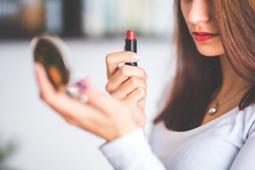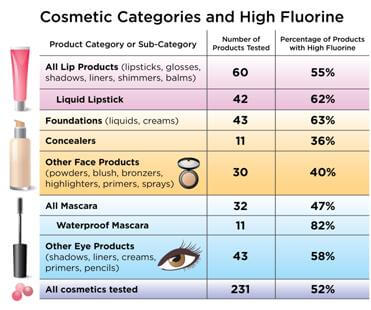June 2021: Ugly Chemicals in Beauty Products
In this edition:
- Are Forever Chemicals Hiding in Your Makeup?
- Watch Now: PFAS in the Built Environment
- An Unwanted Ingredient: Chlorinated Paraffins
- Welcome to Our New Science and Policy Fellow Lydia
- CALENDAR
With the pandemic winding down here in the U.S. and summer on the horizon, our team at the Green Science Policy Institute is looking forward to moving back to our office in July as well as summer vacations. I hope you are able to reunite with your friends and loved ones and continue to enjoy the outdoors as well as restaurants, theaters, and shops as they open up.
Now that socializing is safer and masks are coming off, some of you might be reaching for your makeup bag. However, you should note a major peer-reviewed study of cosmetics just released by the Universities of Notre Dame, Indiana, and Toronto, and our Institute. We found fluorine—indicating the likely presence of PFAS—in just over half of the makeup we tested. These persistent chemicals were most prevalent in waterproof mascara, liquid lipstick, and foundation. Surprisingly, most of the cosmetics that contained PFAS did not list these chemicals on their ingredients label. The study received widespread media coverage, including in The Guardian, CNN, Washington Post, AP, and Good Morning America.
To address this problem, Senators Susan Collins and Richard Blumenthal, Representative Debbie Dingell, and others are introducing the bipartisan No PFAS in Cosmetics Act, which would ban all PFAS in makeup and personal care products. To learn more about our study and the bill, you can read our op-ed in The Hill. Please ask your representatives to support the bill.

The same day—June 15, 2021—that our joint paper went on line and the legislation was introduced, our Institute facilitated a very successful virtual press conference. Senator Blumenthal from Connecticut, Representative Dingell from Michigan, distinguished attorney Rob Bilott, noted toxicologist Linda Birnbaum, as well as Senior Scientist Tom Bruton and I from our Institute spoke to about 200 journalists, cosmetics manufacturers, retailers, and others about our paper finding PFAS in cosmetics and the No PFAS in Cosmetics Act. We hope that our research plus the possibility of new regulation will encourage cosmetics manufacturers and retailers to quickly stop the use of PFAS in makeup. Please check out the recording of the press conference and pass it on.
We’ve also continued to share our finding that PFAS are widespread in building materials. Last month we presented our report tracking the use of these forever chemicals to the design and building communities. Based on our work, we are optimistic the industry can reduce this use of PFAS so that buildings (and their inhabitants) will be healthier. See the blurb below for videos of presentations from our Senior Scientist Tom Bruton, distinguished attorney Rob Bilott, and me.
Our communications strategy is what puts all this research in the hands of people who can take action to protect our health from toxics—legislators, manufacturers, retailers, and more. We have a new page on our website dedicated to our research and communication strategy, featuring useful videos and resources. Our small Institute has initiated large changes protecting our health from flame retardants and PFAS following this strategy. Please share with other scientists who would like to increase the reach and impact of their research. Also let us know if you have any ideas for helping us share our strategy with more scientists.
Finally, are you in the market for flame retardant-free insulation? If so, we have some available for free. Contact Seth Rojello Fernández ([email protected]) for more information.
We wish you a healthy and happy summer,
Arlene and the Green Science Policy team
Are Forever Chemicals Hiding in Your Makeup?
by Rebecca Fuoco
Even if you’re a strict label-checker like me, your makeup routine may be exposing you to potentially harmful PFAS. Our scientists were part of a team led by the University of Notre Dame that found high fluorine levels —indicating the probable presence of PFAS—in just over half of makeup tested. Some of these products underwent further analysis and were all confirmed to contain at least four PFAS of concern. The majority of products with high fluorine, including all but one of those confirmed to have PFAS, had no PFAS listed on the label.
These are not chemicals you want to be slathering on your face. Some PFAS have been associated with a wide range of serious health harms, from cancer to obesity to more severe COVID-19 outcomes, and they contaminate the drinking water of millions.
PFAS in makeup may be ingested when worn on the lips or absorbed through the skin and tear ducts. On top of these direct exposure routes, PFAS can make their way into our drinking water, air, and food during the manufacture of makeup and after it’s washed down the drain.
The potential harms of using PFAS in makeup far outweigh any waterproofing or smoothing benefits they may give these products. That’s why Senators Susan Collins and Richard Blumenthal, and others have introduced the No PFAS in Cosmetics Act to ban these chemicals from makeup and personal care products. Watch our recorded June 15 press conference and join me in asking your representatives to support this important bill.
Watch Now: PFAS in the Built Environment
Our Institute’s new report documents the surprising range of PFAS uses—from floors to roofs—in the building products that surround us. Use of these “forever chemicals” causes harm throughout the lifecycle of building products, from manufacturing, to use, to disposal. On May 13, Arlene Blum and Tom Bruton of our Institute were joined by noted attorney Rob Bilott for a discussion of the report’s findings and the path forward to healthier buildings and reduced PFAS use. You can watch these talks below and learn more on our website.
- Arlene Blum, Green Science Policy Institute
Introduction - Rob Bilott, Taft Stettinius & Hollister LLP
Overview of the PFAS Problem - Tom Bruton, Green Science Policy Institute
PFAS Uses in Building Materials - Arlene Blum, Green Science Policy Institute
Success Stories and the Path Forward
An Unwanted Ingredient: Chlorinated Paraffins
By Lydia Jahl
Modern kitchens often contain numerous appliances to make the perfect gourmet meal. However, your kitchen may contain an unwanted ingredient: a class of flame retardants called chlorinated paraffins. These chemicals are toxic, persistent, bioaccumulative and listed for elimination in the Stockholm convention. Still they are produced in very high volumes and used in products as flame retardants, plasticizers and lubricants. Because of such uses, short-chain chlorinated paraffins, possible human carcinogens, have been detected in human livers, kidneys, fat, and breast milk.
In 2017, Swedish scientists found that 12 out of 16 hand blenders tested leaked chlorinated paraffins into food, likely from direct contact between the food and blender components. The researchers estimated that adults in Sweden using a hand blender once per day could increase their dietary intake of chlorinated paraffins up to 26 times their normal exposure from food.
Recent testing of many kitchen appliances found that chlorinated paraffins are commonly used to lubricate hinges in products such as refrigerators, microwave ovens, and food processors. In their study, brand-new appliances had the highest concentrations, suggesting chlorinated paraffins are released over time.
To reduce your exposure, clean products frequently, do not allow your food to contact the lubricant in appliances, and ventilate your kitchen while using a baking oven. Learn more about flame retardants and how to avoid them at our Six Classes website.
Welcome to Our New Science and Policy Fellow Lydia

We are delighted to welcome Lydia Jahl to the growing team of scientists at our Institute. She will work on limiting the unnecessary use of flame retardants and other challenging issues that impact human and environmental health. Lydia's doctoral dissertation focused on the atmospheric processing of biomass burning emissions, advancing the understanding and modeling of how these emissions affect the climate.
Lydia holds a Ph.D. in Chemistry from Carnegie Mellon University and a B.S. in Chemistry from Harvey Mudd College.
CALENDAR
July 9, 2021:
ANHE Workshop on Toxic Chemicals in our Everyday Lives
9:00am - 3:15pm Pacific
This workshop is a Continuing Education Course for nurses, hosted by the California Alliance of Nurses for Healthy Environments (ANHE). The Institute's Science and Policy Senior Associate, Dr. Carol Kwiatkowski, is one of several speakers presenting during the workshop. She will be speaking about our Institute's Six Classes approach tochemicals management. Register here.
October 3-7, 2021:
FLUOROS Global 2021: International Perspectives on PFAS Science
This multidisciplinary international conference is back in a hybrid (in-person and virtual) format. The meeting will cover the latest developments and scientific advances on PFAS and their adverse health impacts for humans and the environment. Learn more here. We are planning a science & policy of PFAS workshop in conjunction with FLUOROS on Sunday, Oct. 3rd. Email [email protected] with questions.
Receive Updates By Email
Subscribe to our monthly newsletter and get these updates delivered right to your inbox!



